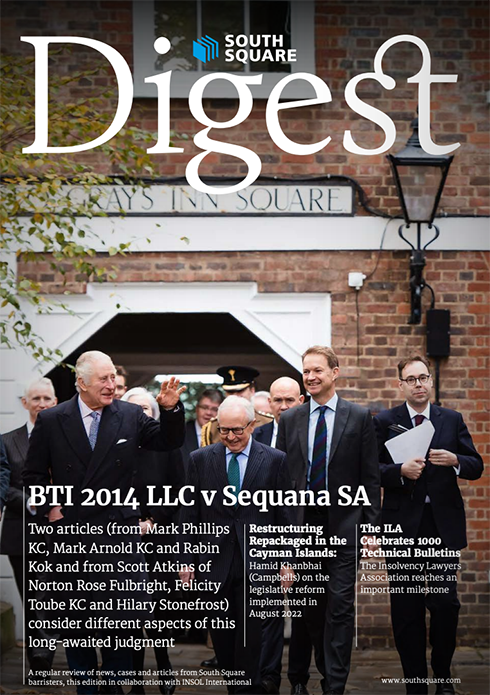

Introduction
The long-awaited decision of the United Kingdom Supreme Court in BTI v Sequana SA1 has generated renewed interest in corporate governance in an insolvency context, and the extent to which a best practice insolvency system can achieve an appropriate balance between creditor protection and managerial risk-taking. Sequana is the first occasion on which the United Kingdom’s highest court has pronounced upon the nature and scope of creditors’ interests as an incident of directors’ duty to act in the best interests of the company. It is not a single judgment, but multiple judgments containing slightly different formulations. While some things are now clear beyond doubt, others are perhaps less clear than they were.
As a result, while the Court has now provided several slightly different formulations of the test to apply when the interests of creditors become material and suggesting what directors need to do to avoid breaching their duties in an insolvency context, considerable uncertainty remains for directors. Moreover, it is one thing to know what the ‘test is’ (or, perhaps, ‘tests are’), but another thing to be able to assess, as a matter of commercial practice and without the benefit of the hindsight applied by a court, where a company sits on a sliding scale of insolvency in ever-changing economic circumstances, such as those that the world is currently facing.
Further, the expectation for directors accurately to weigh competing insolvency outcomes and determine the probabilities of risks and returns across different creditor classes, especially in a corporate group context, might be said to be approaching the impossible. The risk is that directors’ managerial prerogative is minimised, with the prospect of personal liability having a significant deterrent impact on directors’ willingness to pursue a restructuring attempt that, inherently, has no guarantee of success.
This article examines these issues by way of a cross-jurisdictional analysis in the United Kingdom and Australia. It begins by outlining the approach to creditors’ interests in an insolvency context in Sequana and the leading Australian authorities, before assessing the creditor protection-risk taking balance and the impact on corporate restructuring.
The question that is posed in this article is whether, while the creditor protection objective is an important part of insolvency policy, it might be argued that it is better met by other actions conferred by insolvency law, such as voidable transactions provisions and liability for insolvent and wrongful trading.
United Kingdom
In the United Kingdom, directors are required by section 172(1) of the Companies Act 2006 (UK) to act in a way which they consider, in good faith, would be most likely to promote the success of the company for the benefit of its members as a whole. This is a codification of the corresponding equitable duty that directors have, as fiduciaries, to act in the best interests of the company.
The brief facts in Sequana were that the directors of a limited company, AWA, caused AWA to distribute a dividend of EUR 135 million to its sole shareholder, Sequana SA, in May 2009. When the dividend was paid, AWA also had a contingent liability relating to environmental clean-up costs for pollution. The value of the contingent liability was uncertain but it gave rise to a real risk of insolvency at some future point in time. The clean-up costs were later quantified as being significantly higher than first estimated, and AWA became insolvent 10 years after payment of the dividend. Proceedings were commenced, alleging the directors had breached their duty to consider the interests of creditors of AWA by paying the dividend notwithstanding the existence of the contingent liability and the risk of insolvency. This argument was rejected at first instance, and the decision was appealed to the Court of Appeal.
In the Court of Appeal, David Richards LJ (as he then was) held, with Longmore and Henderson LJJ agreeing, that while directors may at certain times be required to have regard to the interests of creditors as an incident of their duty to act in the best interests of the company, the interests of creditors are invoked not merely when there is a ‘realistic prospect of insolvency’, but rather when directors know or should know the company is or is likely to become insolvent. A risk of insolvency in the future, however real, was said to be insufficient unless it amounts to a ‘probability’. However, the Court of Appeal made it clear that where the trigger point had been reached, the duty was owed entirely to the creditors.
In the factual circumstances, while at the time the dividend was paid there was a real prospect of future insolvency, AWA was not likely to become insolvent. This meant the requirement to take into account the interests of creditors was not engaged, and so the directors could not have breached their duties.
On appeal to the Supreme Court, Lord Reed (with Lord Hodge, Lord Briggs, Lady Arden and Lord Kitchin agreeing on the conclusion, although each writing separate, differing judgments) held that directors do not owe any separate duty to act in the best interests of creditors. Rather, the statutory and fiduciary duty remains to act in good faith in the best interests of the company, and ‘there are circumstances in which the interests of the company’ for the purpose of that duty ‘should be understood as including the interests of the company’s creditors as a whole’.2
According to Lord Reed:
So long as a company is financially stable and is therefore able to pay its creditors in a timely manner, the interests of its shareholders as a whole … can be treated as the company’s interests for the purposes of the directors’ duty to act in its interests. It is the shareholders whose interests are affected by fluctuations in its profits and reserves, as they are the persons entitled to share in its distributions and its surplus assets … [T]he creditors’ interests do not require to be considered as a discrete aspect of the company’s interests for the purposes of the directors’ fiduciary duty to the company. It is sufficient for the directors to promote the interests of the shareholders in order for the company’s business to be carried on over the long term and for the company’s debts to be paid as part of the conduct of its business.3
However, the situation changes when the company is ‘insolvent or bordering on insolvency’. In this case:
As losses are incurred, and the company’s surplus of assets over liabilities disappears, the company’s creditors as a whole become persons with a distinct interest (possibly, depending on the gravity of the company’s financial difficulties) in its affairs, as they are dependent on its residual assets, or on the possibility of a turnaround in its fortunes, for repayment.4
Lord Reed referred to the traditional view that creditors are ‘responsible for the protection of their own interests’, which ‘casts upon creditors the risk of the company’s failure’.5 This is based on the underlying concepts of limited liability and the separate legal personality of the company, as well as ‘the fact that the relationship between creditors and the company is usually contractual’,6 so that creditors ‘can be expected to be the guardians of their own interests’.
However, Lord Reed observed that both company law and insolvency law have always recognised that creditors should not be ‘bereft of legal protection’ and:
Acceptance of the need for limited liability to encourage entrepreneurial activity does not in itself justify the view that, even when a company is insolvent or in the vicinity of insolvency, the directors’ duty to act in the interests of the company requires them to act solely in the interests of its shareholders.7
According to Lord Reed:
To treat the company’s interests as equivalent to the shareholders’ interests in that situation encourages the taking of commercial risks which are borne primarily not by the shareholders but by the creditors, who will recover less in a winding up if the company’s assets have been diminished or if it has taken on additional liabilities. In economic terms, treating the company’s interests as equivalent to the shareholders’ interests in a situation of insolvency or near-insolvency results in the externalisation of risk: losses resulting from risk-taking are borne wholly or mainly by third parties.8
It follows that where directors are under a duty to act in good faith in the interests of the creditors, the shareholders cannot authorise or ratify a transaction which is in breach of that duty. The Court was unanimous in reaching this conclusion.
In terms of precisely when the interests of creditors are relevant, the Supreme Court held that a ‘real risk’ of insolvency is insufficient. That is because a real risk of insolvency ‘is at one very large remove’ and is ‘simply too remote from the event which turns a creditor’s prospective entitlement into an actual one’. Indeed, a real, but not probable, risk means that insolvency ‘is by definition unlikely, and insolvent liquidation may only be a remote possibility’.9 Rather, the need to take into account creditors’ interests is invoked when directors know, or ought to know, that the company is insolvent or facing imminent insolvency, or that an insolvent liquidation or administration is probable.10
This timing issue meant that the requirement to take into account the interests of creditors was not invoked on the facts, and this was sufficient to reject the appeal. Nevertheless, by way of obiter, the Supreme Court elected to comment further on what the duty to take into account the interests of creditors actually requires from directors in practice.
Lord Reed suggested that a careful balancing exercise is involved:
Where the company is insolvent or bordering on insolvency but is not faced with an inevitable insolvent liquidation or administration, the directors’ fiduciary duty to act in the company’s interests has to reflect the fact that both the shareholders and the creditors have an interest in the company’s affairs. In those circumstances, the directors should have regard to the interests of the company’s general body of creditors, as well as to the interests of the general body of shareholders, and act accordingly. Where their interests are in conflict, a balancing exercise will be necessary … [I]t can I think be said as a general rule that the more parlous the state of the company, the more the interests of the creditors will predominate, and the greater the weight which should therefore be given to their interests as against those of the shareholders. That is most clearly the position where an insolvent liquidation or administration is inevitable, and the shareholders consequently cease to retain any valuable interest in the company.11
In other words, there was a sliding scale where the interests of the creditors became more important, the closer that the company comes to insolvency. An otherwise lawful dividend (if made in accordance with the requirements of the Companies Act 2006 (UK)) could be made in breach of duty if the trigger point has occurred and the company’s directors failed to act in accordance with their duties. However, Sequana was not such a case.
The Supreme Court did not express any conclusion as to whether the directors should be judged on whether they knew (or ought to have known) that the trigger point had been reached. This is a point that has been left open for submissions in future cases and consideration.
Finally, there was unanimity between all members of the Court that there is no conflict between the creditor duty and the prohibition against wrongful trading in section 214 of the Insolvency Act 1986 (UK).12
If matters had ended here, at least the test would have been clear(ish). But there are some notable differences in the judgments which, to put it at its lowest, make the position rather less clear.
Lord Briggs (with whom Lord Kitchen agreed) stated that the relevant duty would be engaged when insolvency is ‘imminent’ (i.e. ‘just around the corner and going to happen’) or when an insolvent liquidation or administration is ‘probable’.13 In contrast, Lord Hodge held that it was ‘at or near the onset of insolvency’14 or when the company is ‘bordering on insolvency’.15 As we have already seen, Lord Reed considered it was when the company is ‘insolvent or bordering on insolvency, or that an insolvent liquidation or administration is probable’,16 a formulation with which Lady Arden agreed, although she also added that it should also apply where ‘the directors plan to enter into a transaction in question would place the company in one of those situations’.17 There are circumstances where these different formulations will lead to different conclusions.
What about knowledge? The majority held that a director’s knowledge or constructive knowledge (i.e. what they ‘ought to know’) was relevant to the onset of the duty. However, Lord Reed and Lady Arden left the question open).18 As noted below, Lady Arden commented that because the progress towards insolvency may not be linear directors should stay informed of the company’s financial position.19
What about the balancing exercise? Lord Briggs put the balancing exercise this way:
Much will depend upon the brightness or otherwise of the light at the end of the tunnel; i.e. upon what the directors reasonably regard as the degree of likelihood that a proposed course of action will lead the company away from threatened insolvency, or back out of actual insolvency. It may depend upon a realistic appreciation of who, as between creditors and shareholders, then have the most skin in the game; i.e. who risks the greatest damage if the proposed course of action does not succeed.20
In Lord Briggs’ judgment, this happens at the point that section 214 of the 1986 Act also becomes engaged.21 No other judge expressed a view as to whether this is correct. In any event, it could be said that the tunnel becomes rather dark when the outcome directors are being called on to assess may expose them to significant personal liability for their actions. Directors are required to assess a factual circumstance that is inherently fluctuating and changing.
As Lady Arden stated:
The progress towards insolvency may not be linear and may occur not as a result of incremental developments but as a result of something outside the company which has a sudden and major impact on it.22
Where a company sits, on a sliding scale, particularly the ‘bordering on insolvency’ stage expressed as a critical marker by Lord Reed, will be difficult to estimate with precision. And yet so much depends on this answer – not only the extent to which the respective interests of shareholders and creditors are relevant, but just how relevant they are.
Even if a director is able accurately to pinpoint the company’s financial condition on the sliding scale, they then face the further difficult task of determining multiple scenarios for shareholders and different sets of creditors, the likely return from each course of action, and the likely success (in terms of the impact on the prospects of company) of each course of action.
And even when the company is ‘irretrievably insolvent’, so that shareholders cease to retain any valuable interest in the company, directors face the unenviable task of needing to balance the competing interests of multiple creditor groups. This difficulty is captured in Lord Reed’s comments that
individual creditors may be in different positions, and may even have conflicting interests: that may be the position, for example, of secured creditors as compared with unsecured creditors. Secondly, the interests of the company cannot be confined to the interests of current creditors as at the time of a given decision by the directors, any more than they can be confined to the interests of current shareholders … [T]he identities of the company’s creditors constantly change so long as debts continue to be incurred and discharged.23
These observations do not provide much comfort to directors, and the fact they are obiter (with different interpretations possible in later cases) might be said to muddy the waters even more.
Australia
As in the United Kingdom, in Australia directors have a statutory duty under section 181(1)(a) of the Corporations Act 2001 (Cth) to act in good faith in the best interests of the company, which corresponds with the same fiduciary duty recognised in equitable jurisprudence.
Australian courts have, in a long line of cases since the 1970s, held that the identity of the ‘company’ corresponds with the interests of creditors when the company is in financial difficulty. The exact time the interests of creditors are invoked has been variously expressed, ranging from when there is a ‘real and not remote risk of insolvency’,24 or the company is operating in an ‘insolvency context’,25 is facing ‘financial instability’,26 or is ‘insolvent or nearing insolvency’.27 However, little elaboration has been provided.
The leading Australian authority which has dealt with directors’ duties in an insolvency context and the scope of the obligation to creditors is The Bell Group Ltd (in liq) v Westpac Banking Corporation (No 9).28
In that case, the Bell Group consisted of various Australian and United Kingdom subsidiaries with common directors. The initial operations of the Bell Group were financed by unsecured loans from six Australian banks and a non-Australian syndicate of 14 banks. Upon encountering financial difficulty, the existing bank loans were refinanced, so that the banks, among other things, took security over all significant assets of the Bell Group and obtained new guarantees from most subsidiaries, thereby obtaining priority over all existing and future creditors. Although the repayment dates for the loans were extended, the banks offered no new finance as part of this arrangement. After the refinancing, the financial position of the Bell Group worsened and liquidators and receivers were appointed to each company. The banks realised their securities and recovered AUD $282 million. In 1995, liquidators commenced proceedings against the banks and the Bell Group directors challenging the refinancing transactions. The action against the directors was discontinued at an early stage and the liquidators elected to continue solely against the asset-rich banks. However, it remained necessary to determine whether the directors breached their duties to the various subsidiary companies, as a positive answer was required to invoke Barnes v Addy29 accessorial liability for the banks.
At first instance, Owen J held that, in approving the refinancing, the directors did breach their duties to the companies. At the time of the refinancing, the Bell Group companies were facing ‘insurmountable endemic illiquidity’ and imminent insolvency,30 and this meant the interests of creditors corresponded with the identity of each subsidiary company that was indebted to them. The effect of the refinancing was that the subsidiaries had no additional working capital to meet their obligations and any future proceeds from the sale of assets would pass directly to the banks.31 Also, in agreeing to the refinancing, the directors removed any prospect that the existing non-bank creditors of the companies could compete with the claims of the banks (who became secured following the refinancing) in the event of insolvency. The breach was said to be ‘egregious’ because the directors failed to make any enquiries to protect the interests of non-bank creditors of the companies.
Owen J held that directors do not owe any independent duty to creditors. However, the duty to act in the best interests of the company requires directors to take into account the interests of creditors when the company is operating in an ‘insolvency context’.
According to Owen J, in assessing what is an ‘insolvency context’:
A financial state short of actual solvency could be sufficient to trigger the obligation to take into account the interests of creditors … Adversity might strike short of actual insolvency and might propel the company towards an insolvency administration. And that is where the interests of creditors come to the fore.32
While acknowledging the difficulty for directors in assessing the exact point at which the interests of creditors are invoked, Owen J said:
I am not convinced that the consideration of other financial states, short of actual insolvency, as a practical test of directors’ actions would necessarily cross the line from difficult to impossible … Judges are paid to make difficult decisions. So too are company directors.33
Owen J’s analysis in relation to the duty of directors to act in the best interests of the company was endorsed on appeal in Westpac Banking Corporation v The Bell Group Ltd (in liq) (No 3).34 In assessing when the interests of creditors correspond with the interests of the company, Drummond AJA said:
I would prefer to say that if the circumstances of the particular case are such that there is a real risk that the creditors of a company in an insolvency context would suffer significant prejudice if the directors undertook a certain course of action, that is sufficient to show that the contemplated course of action is not in the interests of the company.35
Drummond AJA noted that the requirement to take into account the interests of creditors was a significant departure from earlier judicial attitudes which left corporate decision-making largely to management.36 However, this was said to be justified because:
The impacts of corporate decision-making on a wider range of interests than shareholders are now being given more recognition. The need to ensure protection of those interests also I think serves to explain why modern company courts have become more interventionist, in reviewing the activities of directors than was traditionally the case.37
The only other decision since Bell which has considered in detail the nature of the interests of creditors as an aspect of directors’ duty to act in the best interests of the company is Termite Resources NL (in liq) v Meadows, Re Termite Resources NL (in liq) (No 2).38 In that case, a claim was brought against the directors of Termite, a mining company. Termite was wholly owned by Outback Iron, itself owned by IMX Resources and Taifeng Yuanchuang International Development. The mining operations of Termite were funded by unsecured loans from IMX and Taifeng to Outback Iron, which then on-lent the funds to Termite.
After IMX encountered financial difficulty, its directors caused Termite to adopt and implement a distribution policy by which, subject to the retention of a reserve of AUD $3 million, all the surplus mining proceeds had to be distributed to IMX and Taifeng. The price of iron ore rapidly declined and the reserve of AUD $3 million was insufficient to pay Termite’s liabilities. Termite went into voluntary administration and then liquidation. It was held that the AUD $3 million reserve under the distribution policy was inadequate and that a reserve of at least AUD $10 million was needed for Termite to survive given the volatile iron ore market.
White J in the Federal Court of Australia held that Termite’s directors breached their duty to act in the best interests of the company, which had clearly been in a situation of doubtful solvency that invoked the interests of creditors. The directors had, on the facts, preferred the interests of IMX and Taifeng to Taifeng’s collective creditors. There was no analysis by management concerning the sufficiency of a reserve of AUD $3 million, taking into account the foreseeable changes in iron ore prices and their implications for the company’s working capital.
White J held that the interests of creditors are invoked in circumstances broader than when the company is ‘nearing insolvency’ or of ‘doubtful solvency’. It is not required for the actions of directors to be likely, on the balance of probabilities, to lead to the insolvency of the company. Rather, the interests of creditors are invoked simply when there is a ‘real and not remote risk of insolvency’ and when the ‘objective circumstances require’ consideration of the interest of creditors.39
This answers the question left open in Sequana as to whether the interests of creditors are invoked only when directors know or ought to know that the company is insolvent or facing imminent insolvency, or that an insolvent liquidation or administration is probable. Such knowledge is not required in Australia.
In terms of what directors are required to do to ensure they sufficiently take into account the interests of creditors, White J cited with approval academic commentary that:
In summary, what directors must do to satisfy their obligation to consider the interests of creditors will vary according to the context. The steps required to be taken by directors will depend upon a number of factors, and these factors will vary from company to company. The factors will include the financial situation of a company (the closer the company is to insolvency, then the greater the weight that should be given by directors to the interests of creditors); the number of creditors the company has; the types of creditors the company has and the amount owed to each creditor; whether the company is part of a corporate group (the existence of a corporate group in the Bell Group litigation meant the directors faced a more complex task in relation to considering the interests of creditors); and the potential impact of any contemplated transactions being considered by the directors on the creditors.40
Analysis – the scope of director liability and the impact on corporate rescue
The current jurisprudence on when directors are required to take into account the interests of creditors in discharging their duty to act in the best interests of the company, and what is required of them in doing so, therefore might be said to raise more questions than answers. The delicate balancing exercise that directors must undertake, with reference to rapidly changing financial and economic conditions and a multitude of competing stakeholder interests, places them in a very difficult position in practice, and this may lead to a significant deterrent impact on the willingness of directors to pursue a corporate restructuring.
It is a hard task for directors to determine when a company is in fact insolvent to begin with, particularly in the current economic circumstances which see various levels of government support and loan and rental deferrals and fluctuating market expectations and financial forecasts by the day due to uncertainties in supply chains, levels of demand from customers, energy prices, and interlinked downside economic risks. There are also the uncertainties of an economy in transition, and how to quantify climate risk exposure based on principles yet to be settled by regulators domestically and internationally.
In light of that overarching difficulty, for directors to be expected to understand and apply a ‘sliding scale’ to assess when a company faces a ‘real but not remote risk’ of insolvency, or is more likely than not to be insolvent, or is sitting in a more generalised ‘zone of insolvency’, is necessarily also subject to imprecision and the potential for genuine, well-meaning error.
If a claim for breach of duty is commenced against a director, the time at which the requirement to take into account the interests of creditors is invoked should not be, but will perhaps inevitably be judged, to some extent, with the benefit of hindsight.
Perhaps the argument put by the banks in Bell at first instance has even more resonance in today’s economy:
Directors do not have the opportunity in which to determine and categorise a series of variables in the financial position of the company at any given time. In the everyday world of commerce, companies’ fortunes commonly fluctuate in a significant and rapid way. It is one thing to impose an obligation where a director forms a belief that a company is insolvent. It is quite another thing to impose an obligation where the company is in a financial state that is less than commercially desirable but does not amount to insolvency.41
The recent decisions in the United Kingdom and Australia do not offer comfort or clarity to directors on precisely what needs to be done in fact to balance the interests of shareholders and creditors, and the interests of different sets of creditors, when the company is at various stages along the ‘insolvency curve’.
The prospect of a workout attempt, whether informal or via formal reorganisation processes, offers no guarantees of success. But if it is successful, a workout will enhance returns for all creditors, and the collective benefit of all creditors aligns with a fundamental intention of insolvency law.
The decision on whether to pursue a rescue attempt for a financially-distressed company involves a strong degree of business judgment – based on relationships with creditors, the context and history of the business, and an assessment of future prospects. In determining a breach of duty based on hindsight, arguably the risk-taking prerogative of directors is displaced.
Directors are effectively required to place percentage values on the likelihood of a rescue attempt succeeding, compared to other insolvency alternatives, and to also estimate a range of expected returns in a multitude of scenarios, the outcome of which rapidly changes by the day in a volatile economy.
This becomes somewhat onerous especially in a corporate group situation. At first instance in Bell, Owen J held that the directors were required to take into account the interests of ‘direct and indirect creditors of individual Bell Group companies’42 and, in a group situation such as this, the duty
demanded a tracing exercise to ascertain the effect on creditors of [the refinancing transactions]. In this respect ‘creditors’ includes indirect creditors, that is, creditors of debtor companies and debtors of creditor companies within the group … The directors did not do that tracing exercise. They did not ascertain the extent of external creditors of individual companies and nor did they consider how those creditors would be affected by what was proposed.43
This tracing exercise across potentially thousands of creditors in different jurisdictions is an exercise of immense complexity – and ultimately requires a significant element of commercial judgment and an element of risk-taking. Yet that judgment call is not reflected in an express defence to personal liability for directors specifically in an insolvency context such as this, although the normal “honest and reasonable” defence will no doubt be raised by directors in these circumstances.
While creditor protection is a legitimate and important policy objective of insolvency law, a careful balance is required between creditor protection and commercial realities which necessitate the exercise of risk taking. One might ask whether the creditor protection objective is already sufficiently met through other core provisions of an insolvency regime – voidable transaction provisions enabling the recovery of uncommercial transactions and unfair preferences, as well as insolvent and wrongful trading provisions.
If those provisions were left to operate – without also imposing a duty for directors to act in the best interests of creditors as the relevant identity of the ‘company’ in an insolvency context – then the decision to pursue a restructuring attempt might be able to be left as a commercial judgment for directors, subject to a lack of good faith or preferential treatment for particular groups of stakeholders.
Such an alternative formulation of directors’ duties could strike a better balance and increase the incidence of corporate rescue for viable entities, at a time when it is very much needed (given the current economic climate) to ensure economic and financial stability, and to preserve jobs, livelihoods and communities. Indeed, the creation of incentives to enhance the incidence of corporate restructuring has been called for by the World Bank44 and the International Monetary Fund45 as a way to navigate the economic difficulties the world is now facing.
Alternatively, the common law duties might play a valuable role in covering circumstances where a company does not enter insolvency, but where there is nevertheless a loss caused by its actions when it was in a perilous time, or for other areas where insolvency actions are not available. Is the purpose of the common law duties to encourage directors to consider the financial position, and to act with care and caution?
It is hoped that this article will serve as a conversation starter in assessing the complexity of corporate governance in an insolvency context, and considering how to strike the right balance to incentivise restructuring outcomes for viable entities, where restructuring outcomes are likely ultimately to be in the best interests of creditors, the broader community, and the economy.
1 [2022] UKSC 25.
2 Ibid, [11].
3 Ibid, [47].
4 Ibid, [48].
5 Ibid, [52].
6 Ibid.
7 Ibid, [53].
8 Ibid, [59].
9 Ibid, [193].
10 Ibid, [203].
11 Ibid, [81].
12 Ibid, [94], [97], [99], [122], [238], and [325].
13 Ibid, [203].
14 Ibid, [231].
15 Ibid, [238].
16 Ibid, [12].
17 Ibid, [279].
18 Ibid, [90] and [281].
19 Ibid, [303]-[304].
20 Ibid, [176].
21 Ibid, [176].
22 Ibid, [303].
23 Ibid, [48].
24 Kalls Enterprises Pty Ltd (in liq) v Baloglow (2007) 63 ACSR 557.
25 Kinsela v Russell Kinsela Pty Ltd (in liq) (1986) 4 NSWLR 722.
26 Linton v Telnet Pty Ltd (1990) 30 ACSR 465.
27 New World Alliance Pty Ltd, Re; Sycotex Pty Ltd v Baseler (1994) 51 FCR 425.
28 (2008) 70 ACSR 1.
29 (1874) 144 ER 643.
30 Ibid, [1949].
31 Ibid, [992].
32 Ibid, [4445].
33 Ibid, [4449]-[4450].
34 (2012) 89 ACSR 1.
35 Ibid, [2046].
36 Ibid, [2049].
37 Ibid, [2051].
38 (2019) 370 ALR 191.
39 Ibid, [209].
40 Ibid, [208].
41 (2008) 70 ACSR 1, [4446].
42 Ibid, [9743].
43 Ibid, [6064].
44 World Bank, Finance for an Equitable Recovery (2022), Chapter 3: Restructuring Firm and Household Debt.
45 International Monetary Fund, Policy Options for Supporting and Restructuring Firms Hit by the COVID-19 Crisis (2022).








![Brake & Anor v The Chedington Court Estate Ltd [2023] UKSC 29](https://southsquare.com/wp-content/uploads/2024/02/Brake-Anor-1-scaled.jpeg)









